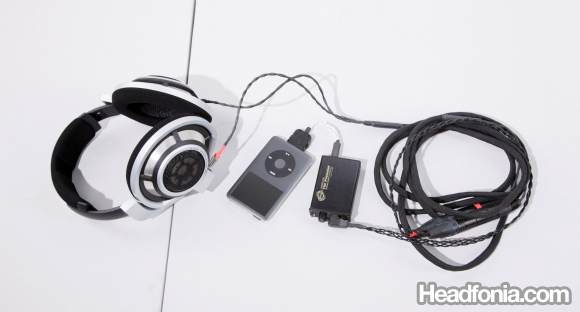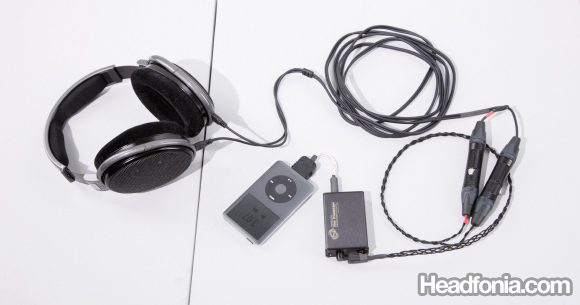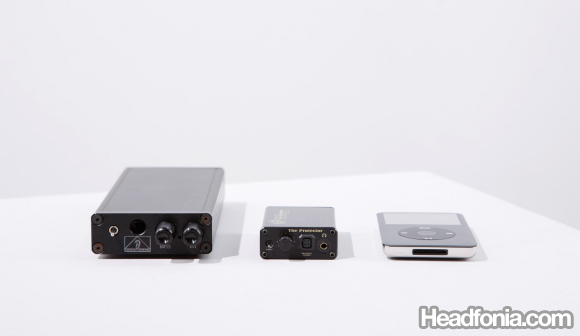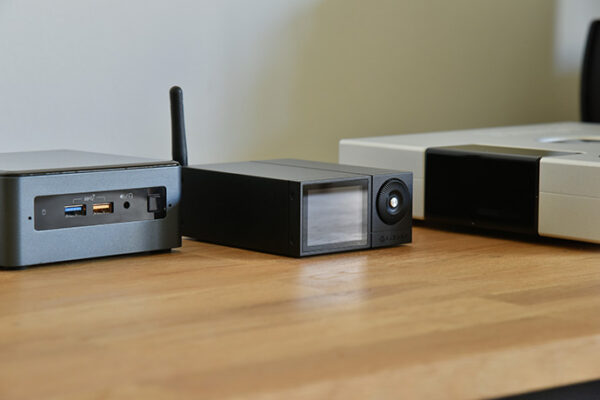Ray advised 100 to 200 hours of burn-in time, but I just got the Protector a few hours ago. I do think that the sound quality out of the box is good enough for initial impressions, but we’ll hold the final review until the amp has been properly burnt.
I really haven’t done much listening in the single ended, since that beats the purpose of having the Protector in the first place. But when plugged in to the single ended jack, the effective gain is lower and you need to crank up the volume higher than if you plug it in to the balanced jack. (In single ended, the effective gain would be half of that in balanced drive) Still, you can get the Protector to drive the HD650 loud enough through the single ended connection, though power wise it’s not as impactful as what you’d get through the balanced drive.
 Moving to the HD800, driven balanced through the Protector, I found that again it was able to drive the Sennheiser to extremely loud levels. But loudness is not equal to properly driven, and so I find the Protector to be a weak combination for the HD800, which is not exactly designed to be driven from a portable amplifier. Also, the HD800 is extremely revealing of the source you’re using, and the Ipod’s DAC is far from what I would call a high end source.
Moving to the HD800, driven balanced through the Protector, I found that again it was able to drive the Sennheiser to extremely loud levels. But loudness is not equal to properly driven, and so I find the Protector to be a weak combination for the HD800, which is not exactly designed to be driven from a portable amplifier. Also, the HD800 is extremely revealing of the source you’re using, and the Ipod’s DAC is far from what I would call a high end source.
Now, let’s go back to the HD650. The HD650 is legendary for having the biggest improvement when driven balanced. As a matter of fact, one of the biggest reason that makes me built my balanced Beta22 was to be able to feel the HD650 on a balanced drive. When driven balanced, the HD650 improves on just about every aspect, probably the biggest improvement you can find when moving from single ended to balanced. But that “transformation” has only been witnessed on big high end desktop amps, because balanced drive was never available on lower end amplifiers, let alone portable ones. So, I really wanted to see if the Protector got what it takes to transform the HD650.
At the same time, I pitched the Protector against the Lisa 3, just to see how the Protector compares to the most powerful portable amplifier on the market even today. The Lisa is humongous for a portable amp, but it also comes with quite a lot of power and a smooth, analog sounding sound, so it was worth carrying around the bulk. Keep in mind that the Protector has only been burnt for roughly 6 hours, and while I feel some harshness on the lower treble, I will wait until the amp is fully burnt before making any final judgments.
I’ve had the Lisa 3 for a few months now, and it has always been a very potent amplifier with a smooth and warm sound signature. The Protector has a lot of disadvantages than the Lisa, both in components (Like all newer portable amplifiers, the Protector uses SMD resistors, as opposed to the metal-film resistors used in the Lisa) and in size. The Lisa does sound more analog and smoother than the Protector. Bass punch on the HD650 was also stronger with Lisa, though the Protector has better control of the bass due to its balanced drive. I don’t know how far the burn in process can improve the Protector, but that’s not my main concern for now.
While the Lisa has enough power to drive the HD650, the HD650, out of the Lisa 3 still sounds like a single ended HD650. But the Protector, with the help of balanced drive, really takes the HD650 to another level. Gone is the boomy bass that’s often prevalent in the HD650, even with the Lisa 3. The soundstage widens, the imaging becomes clearer, and the ambiance more real when the HD650 is driven balanced from the Protector. So, while the refinement level of the Protector is still inferior from the Lisa, I do find that the changes brought by the balanced drive offers sonic improvements that the Lisa was not able to provide.
In order to be able to drive a headphone in balanced mode, the amplifier needs to be fed a balanced signal that consists of 3 lines for every channel: Signal (+), Inverted (-), and Ground. Unbalanced sources only output the Signal (-) and Ground for every channel, thus lacking the Inverted (-) signal needed. The Protector overcomes this problem by using a phase splitter chip, so it takes the Signal (+) from your DAP and generate the Inverted (-) signal (exact same signal but inverted 180 degrees), and so come up with all the necessary signals. There were some concerns about the phase splitter chip becoming a weak link in the system. Though theoretically those concerns might be valid, I didn’t feel any noticeable degradations in the implementation of the phase splitter in the Protector. On the contrary, as I have mentioned, the transparency, sound stage, imaging, and ambiance is improved through the Protector’s balanced drive. I think we can be satisfied with this solution, until someone designed a portable balanced DAC that can take the digital data from the Ipod.
While the Protector is far from the ultimate HD650 amplifier, I do feel that the Protector does a very good job of driving the HD650. Nothing feels really lacking from this combination, and if I need to be stuck with just one amplifier, I would be very happy with the HD650 and Protector combo. But of course, the Protector was designed to drive your custom multi driver IEMs (such as the JH13 and the UM Mage) to levels never heard before, and so that’s when the real review will come in.
In the mean time, while I’m waiting for the UM balanced cable to arrive, I’ll use this opportunity to put burn in the Protector to the recommended 200 hours mark. Stay in tune!
System for auditioning:
Headphones: HD800 with APureSound cable, HD650 with stock cable.
Source: Ipod Classic, ALAC files. Cowon D2
Amplifier: RSA Protector, Lisa 3 Standard
Interconnects: DIY Blue Dragon LOD. Kimber cable XLR to Protector adapter.












Mike
This is the stupidest idea ever!
Why would you need a BALANCED portable headphone amp?
Balanced connections are only needed to reduce/eliminate RFI (radio frequency interference). That is why microphones use balanced connections. RFI can be a problem with cables a hundred or more feet long.
A balanced connection offers absolutely no benefit for portable audio. The cord is likely only inches long and it is unlikely to be used in an area, such as inside a radio station, that has high RFI.
If you want to look like an idiot, buy this device and walk around with it.
http://en.wikipedia.org/wiki/Balanced_audio
Mike
Hi Mike, you're not all-knowing and there are things that you happen to not know.
Fabio
Hello Mike,
It’s interesting that you found this tiny little amp did a very good job in driving HD650. I heard that RSA will put out new portable balanced amp, SR-71B I guess. That’s why I asked you these following questions:
I haven’t tried RSA product before, do you think this amp warm or neutral? Did you find it analytical? How about its speed, dynamic, and PRaT?
Just out of my curiosity, what technicalities of sound quality differentiate this amp from Balanced Beta22? I know it’s unfair, but I’m wondering what your response would be. Night and day difference?
I’m in the market looking for affordable balanced amp to drive my HD650, any other recommendations buddy?
Thanks.
Mike
Hi Fabio, yes it's surprisingly quite good in balanced.. but compared to the Beta22, the difference is night and day. It's like putting me in a basketball game against Jordan, James, or Kobe, if you know what I mean. Anyway, the RSA sound is mostly toward warm and slightly dark. Speed, dynamics, PRaT, are quite good. Not the best I've heard, but not too shabby either.
Now as for alternatives, Ibasso PB1 is the first one that comes to mind. With the PB1, Ibasso has finally manage to bring the quality of their amps to the same level of the US brands. I've never compared the Protector to the Ibasso PB1 directly (perhaps I should do that), and I've never used the Ibasso PB1 in balanced yet (don't have the Hirose connector), but I think at half the price of the Protector, the PB1 is quite a worthy alternative. It's also not as dark as the Protector which I think should match the HD650 better.
http://www.headfonia.com/ibasso-pb1-toucan-unboxi…
Jeremy
Hi Mike, I've been enjoying your website for a couple of weeks now. Great job! I have learned so much. You seem to have such a keen ear and you always seem to know what amp to pair with what headphone. My question is I'm about to purchase the JH16 pro and I think I want a portable balanced headphone amp to go with them. Do you have any thoughts on this? I know there is the Ibasso PB1 and the RSA protector. There may be others. Thanks, I look forward to hearing from you.
Jeremy
Mike
Hey Jeremy, thanks for the very kind words. The Protector and the JH16 is a good combination, and the only one that I've had the chance of using balanced with my customs. I really haven't tried the PB1 for balanced so I can't say much on that, although I like the PB1 than the Protector as it is less dark sounding. I think RSA is coming out with the new quad-mono portable amp, and I think ALO is also coming up with a balanced portable amp.
Jeremy
Thanks for responding so quickly. If the protector is a bit dark, I can see that it might not be the best for the 16pro. Do you have a recommendation as to the best portable amp available for them. While i enjoy bass and want something that would be the best accompaniment. Thanks again, Jeremy
Mike
Hi Jeremy, you can try the Ibasso PB1. Though I have no experience with their balanced drive, they're quite great in single ended. Personally for me, I think the Pico Slim is my favorite pairing for the JH16, as it is quite a bright amp compared to the PB1 and the Protector. The JH16 is naturally great at bass, you need not worry about the bass performance.
Andrew
well, i have been using the pico slim for awhile. However, i do not like the vocals being laidback with respect to the rest of the music.
Mike
Oh, is that what you find? I actually find the opposite with te pico. Well, still back to the original question, I really can't say much about the pairings with the UM3x, haven't listened to it for a long time. I just didn't enjoy the UM3X with RSA amps, too dark of a combination I feel.
Andrew
So the pico slim brings forward the vocals for you? COuld mine be faulty?
Mike
It does make vocals more forward, but it doesn't put a spotlight in just the vocal. I doubt its faulty, probably more of a result of different recordings and IEM combination.
Andrew
Hi mike, ive recently tried my um3x paired with a mustang and liked the outcome. Would the protector be better than the mustang single ended? I would be using it single ended since my um3x cables are not detachable but would like the balanced connector for future upgrades.
Mike
Unless you want to go balanced, I see little point in upgrading to the Protector. Within RSA's house sound, the result should be about the same. The Pico Slim would is a good alternative to try.
Andrew
Hmm, i found it more difficult to follow lyrics using the slim. Vocals in certain segments of tracks also fail to catch my attention when they would when i was going ampless.
Mike
I still doubt that your Pico is faulty, as faulty amps normally manifests as distortions in the sound or complete no sound. Yet your impressions are puzzling. The pico is probably the portable amp with the best control today. Everytime I listen to it I am amazed at how clear it makes my music sound. Even in comparison with other amps, using relatively easy to drive IEMs like the dual drivers.
Oh well, I really can't explain what's happening on your set up.